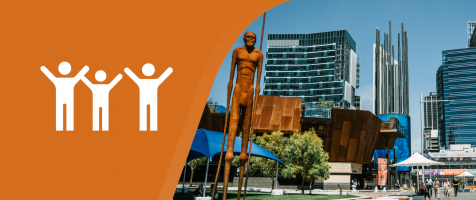WA is one of the most culturally diverse states in Australia and is home to people from over 190 countries who speak approximately 240 languages and dialects (including around 50 Aboriginal languages). Its capital, Perth, is one of the world’s most liveable cities and was ranked sixth globally in 2021. While scoring very well in most measures, lower scores in components of the culture and environment category, which includes cultural and sporting availability, have impacted Perth’s global ranking over the decade to 2021.
Strategic justification
Increased strategic investment is required across arts, culture, sport, recreation and tourism infrastructure to ensure WA remains a sought-after place to live, visit, study and invest. Unified and compelling strategic planning, equitable access to sporting facilities, and investment in major infrastructure assets and tourism attractions will provide the vision and direction currently needed by the sector.
Sector challenges and opportunities
A unified, flexible and compelling strategy that identifies the needs for arts and culture and the subsequent potential infrastructure responses does not currently exist. Throughout the state, there is a lack of a shared vision and coordinated approach to building liveable cities to attract residents and tourists.
Catchment areas for regional-level sporting facilities are large and often cross local government boundaries which can make it difficult to translate needs into the planning, acquisition, funding and delivery of sites, particularly when large land areas need to be put aside early in the planning phase.
Historical challenges in prioritising and integrating ACSR infrastructure into government decision making has led to under-investment, constraints in community access and limits on potential related economic opportunities.
While the WA Recovery Plan includes some investment in the sector, a significant long-term funding shortfall in the sector is the legacy of intermittent and lower levels of investment over many years.
Much of WA’s ACSR infrastructure is aged, costly to maintain or due for major upgrade or replacement. This is particularly relevant for Perth’s convention and exhibition facilities, the Perth Convention Precinct, and the Perth Cultural Centre. Across the state, the size and range of the infrastructure asset base presents many challenges for organisations that are responsible for their management.
Tourism-related infrastructure is delivered by a range of state agencies rather than being centrally planned, coordinated and delivered. This can result in investment decisions that often overlook the flow-on impacts of increased visitation and a lack of sufficient funding to realise wider tourism-related infrastructure needs (such as car parks, visitor facilities, signage and information required when upgrading roads).
Tourism makes a vital contribution to regional economic growth, diversification and employment. Nature based activities and adventure tourism provide opportunities as major attractors for tourists. WA is home to some of the world’s most unique natural and cultural assets. Combined this presents the opportunity for WA to capitalise on demand through investment in tourism-related assets.
Aboriginal empowerment and self-determination, which has many flow-on impacts, can be supported in part through a sustainable Aboriginal tourism sector. A nationally relevant and internationally recognised flagship Aboriginal cultural centre will provide a much-needed opportunity to showcase and celebrate WA’s world-renowned Aboriginal culture and improve cultural understanding for Western Australians and visitors to the state.
Sport also provides direct social and economic benefits to WA. Sporting clubs and activities bring people and communities together and the positive impact of an active lifestyle on physical and mental health is widely understood. An opportunity exists to maximise these benefits and outcomes through the delivery of priority capital works proposed in the State Sporting Infrastructure Plan.
Arts and culture bring vibrancy and cultural depth to the state, contributing to economic diversity and growth. Recent major investments, such as the WA Museum Boola Bardip and State Theatre Centre, demonstrate the diverse benefits that can be derived from arts and culture infrastructure.
Case study
Main Roads WA is sealing 271 km of the Manuwarra Red Dog Highway between Karratha and Tom Price. Stages 1 to 3 are complete, with work on the final 108 km (Stage 4) due to commence in mid-2022. This project delivers many benefits, including improved connectivity, safety and reduced travel time. It also presents an opportunity to grow the tourism industry in the Pilbara and leverage the richness of the region’s unique cultural and environmental features through provision of greater access to 2 of WA’s premier national parks – Karijini and Millstream Chichester. For further information, refer to: https://www.mainroads.wa.gov.au/projects-initiatives/all-projects/regional/karratha-tom-price/

